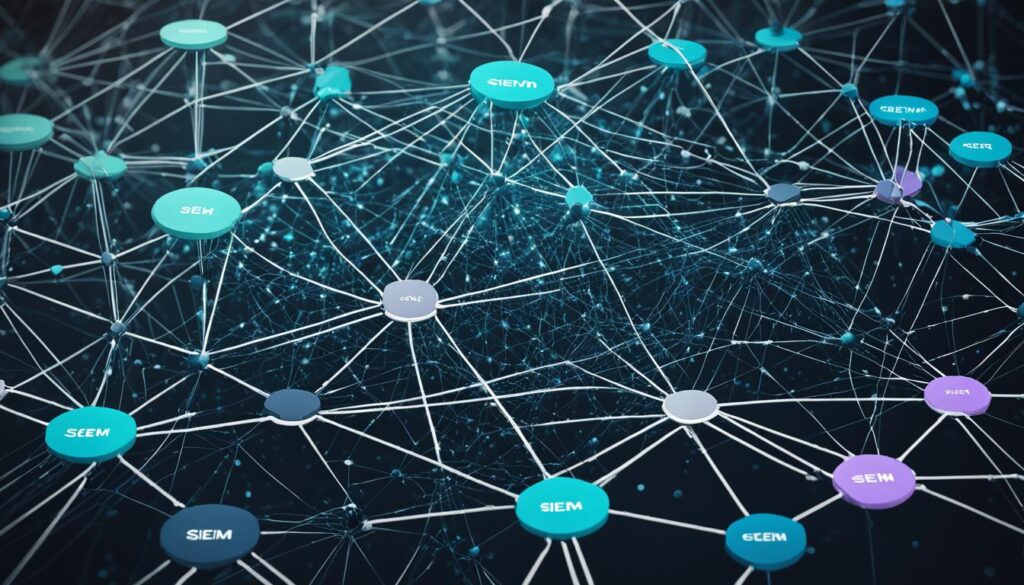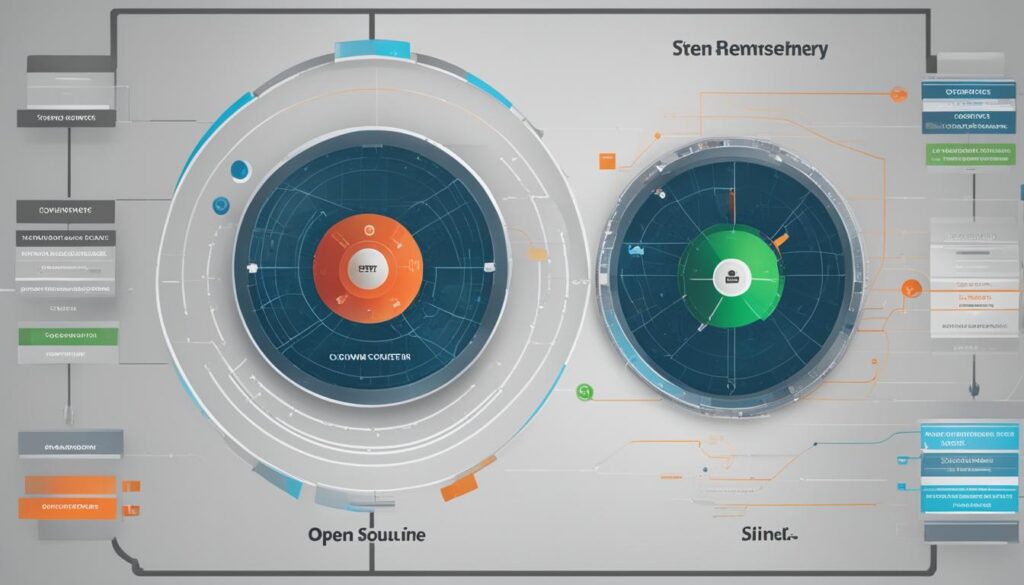A proprietary SIEM system is an advanced technology that safeguards your organization’s cybersecurity.
With its powerful capabilities, this technology can help you detect and respond to threats, investigate security incidents, and ensure compliance with regulatory requirements.
Contents
- 1 SIEM Architecture and Log Management
- 2 SIEM Benefits and Use Cases
- 3 Next-Generation SIEM and Advanced Capabilities
- 4 SIEM Deployment Models and Considerations
- 5 Conclusion
- 6 FAQs
- 6.1 What is a proprietary SIEM system?
- 6.2 What components are included in a SIEM system?
- 6.3 What benefits does a SIEM system offer?
- 6.4 What are some use cases for SIEM systems?
- 6.5 What are the advanced capabilities of next-generation SIEMs?
- 6.6 What are the different deployment models for SIEM systems?
- 6.7 What factors should be considered when selecting a SIEM deployment model?
- 7 Source Links
Key Takeaways:
- Proprietary SIEM systems are developed and owned by specific organizations or vendors.
- These systems collect and analyze log and event data to provide actionable security insights.
- Advanced capabilities of proprietary SIEM systems include threat intelligence, correlation and security monitoring, analytics, alerting, compliance, retention, forensic analysis, threat hunting, and incident response.
- Some examples of proprietary SIEM systems are Splunk, StealthWatch, and NetFlow Collector.
- A proprietary SIEM system can help organizations enhance security posture and effectively manage cybersecurity challenges.
SIEM Architecture and Log Management
Understanding an SIEM system’s architecture and log management is crucial.
A well-designed SIEM architecture comprises various components and capabilities that provide comprehensive security information and event management. These components include:
- Threat intelligence: Collects and analyzes data to identify known threats and indicators of compromise.
- Correlation and security monitoring: Detects patterns and correlations between events to uncover potential security incidents.
- Analytics: Utilizes advanced algorithms to analyze large volumes of data and identify anomalous behavior.
- Alerting: Generates alerts and notifications when potential security threats are detected.
- Dashboards: Provides visual representations of security data for monitoring and analysis.
- Compliance: Ensures adherence to industry regulations and standards.
- Retention: Manages log and event data storage and retention for future analysis.
- Forensic analysis: Enables detailed investigations into security incidents for root cause analysis.
- Threat hunting: Proactively searches for potential security threats and vulnerabilities.
- Incident response and SOC automation: Automates incident response processes and streamlines security operations.
Log management is critical to SIEM, as it involves collecting, managing, and retaining data.
SIEM systems use various methods to collect logs and events from different organizational strategies, including agents, network protocols, log file access, and event streaming protocols.
Once collected, the data is stored and optimized for efficient analysis and exploration. This ensures that the SIEM can quickly and accurately detect and respond to security incidents.
Also read: Explore Smart Home Wireless Technology Today
Next-generation SIEMs leverage modern data lake technology to allow organizations to store and analyze vast amounts of data cheaply.
With practically unlimited data storage capabilities, organizations can retain logs and events for extended periods, enabling comprehensive forensic analysis and threat detection.
Additionally, SIEMs incorporate log filtering, summarization, and deletion schedules to reduce log volumes and retain only essential information for compliance and forensic purposes.
Example SIEM Architecture
| Component | Description |
|---|---|
| Threat Intelligence | Collects and analyzes data to identify known threats and indicators of compromise. |
| Correlation and Security Monitoring | Detects patterns and correlations between events to uncover potential security incidents. |
| Analytics | Utilizes advanced algorithms to analyze large volumes of data and identify anomalous behavior. |
| Alerting | Generates alerts and notifications when potential security threats are detected. |
| Dashboards | Provides visual representations of security data for monitoring and analysis. |
| Compliance | Ensures adherence to industry regulations and standards. |
| Retention | Manages the storage and retention of log and event data for future analysis. |
| Forensic Analysis | Enables detailed investigations into security incidents for root cause analysis. |
| Threat Hunting | Proactively searches for potential security threats and vulnerabilities. |
| Incident Response and SOC Automation | Automates incident response processes and streamlines security operations. |
Understanding a SIEM system’s architecture and log management is vital for successful implementation.
It enables organizations to establish robust security monitoring, detect and respond to threats effectively, and ensure compliance with industry regulations.
SIEM Benefits and Use Cases
Implementing an SIEM system offers organizations many benefits, enhancing security posture and streamlining operations. Take a look at some of the key benefits and use cases of SIEM:
Improved Threat Detection Capabilities
By collecting SIEM systems, organizations are provided with improved threat detection capabilities by analyzing log and event data from various security systems, networks, and computers. SIEM allows them to promptly identify and respond to potential security incidents, reducing the risk of data breaches and cyberattacks.
Efficient Incident Response
SIEM systems play a crucial role in incident response by providing real-time alerts and enabling security teams to investigate and mitigate security incidents quickly.
This helps organizations minimize the impact of the incident and restore normal operations swiftly.
Enhanced Compliance and Reporting
SIEM systems assist organizations in meeting regulatory compliance requirements by collecting, analyzing, and reporting on security events.
They help automate compliance management processes, reducing manual efforts and ensuring adherence to industry standards.
Also read: Discover Which Technology Shifts Your Desktop
Increased Visibility into Security Events
With SIEM, organizations gain a comprehensive view of their security events. SIEM platforms consolidate and correlate log and event data from multiple sources, enabling security teams to monitor and analyze security incidents more effectively.
This increased visibility helps identify trends, patterns, and anomalies that might go unnoticed.
Proactive Threat Hunting
SIEM systems empower security teams to proactively hunt for potential threats before they can cause significant damage.
By leveraging advanced analytics and threat intelligence, organizations can detect and address emerging threats, reducing their vulnerability to cyber-attacks.
Automated Security Orchestration and Response
SIEM systems automate security processes and workflows, enabling organizations to respond to security incidents more efficiently.
By automating repetitive tasks and integrating with other security technologies, SIEM automates incident response procedures, allowing for faster and more effective threat mitigation.
SIEM Use Cases
- Detecting and mitigating advanced threats
- Identifying and responding to security incidents
- Monitoring user and entity behavior to detect anomalies
- Analyzing logs and events for forensic investigations
- Automating security processes for efficient incident response
SIEM systems offer comprehensive benefits and use cases across various industries and sectors.
Organizations can leverage SIEM to strengthen their security defenses, proactively detect threats, and respond effectively to security incidents, from finance and healthcare to government and retail.
| SIEM Benefits | SIEM Use Cases |
|---|---|
| Improved threat detection capabilities | Detecting and mitigating advanced threats |
| Efficient incident response | Identifying and responding to security incidents |
| Enhanced compliance and reporting | Monitoring user and entity behavior to detect anomalies |
| Increased visibility into security events | Analyzing logs and events for forensic investigations |
| Proactive threat hunting | Automating security processes for efficient incident response |

Next-Generation SIEM and Advanced Capabilities
Next-generation SIEMs are designed to go beyond the capabilities of traditional SIEM platforms. They offer advanced features and functionalities tailored to address the evolving threat landscape.
These advanced capabilities make next-gen SIEMs a powerful tool for organizations looking to enhance their cybersecurity defenses.
One of the vital advanced capabilities of next-generation SIEM is User and Entity Behavior Analytics (UEBA). This feature leverages AI and machine learning algorithms to analyze patterns of human behavior within an organization’s network.
By monitoring user activities, UEBA can detect insider threats, targeted attacks, and fraudulent behavior that could go unnoticed by traditional SIEM systems.
“User and Entity Behavior Analytics provides organizations with valuable insights into the behavior of internal users, enabling them to identify potential security risks and take proactive measures to mitigate them.”
Another advanced capability of next-gen SIEM is Security Orchestration and Automation Response (SOAR). SOAR enables organizations to automate their incident response procedures and investigations.
With SOAR, security teams can streamline their workflows, reducing response times and enhancing their overall efficiency in addressing security incidents.
Next-generation SIEMs also excel in complex threat identification and detection. They can identify and respond to threats without relying on predefined rules or signatures.
This ensures that organizations can avoid emerging threats that may not yet have established patterns or signatures.

Next-gen SIEMs also offer powerful capabilities in analyzing lateral movement within an organization’s network.
By tracking and analyzing the movements of threats across different systems and entities, these SIEMs can provide valuable insights into the extent of a security breach and the potential impact on the organization.
Furthermore, next-generation SIEMs excel in entity behavior analysis. This involves analyzing the behavior of network entities such as applications, servers, and IoT devices.
By detecting abnormal behaviors and deviations from baseline patterns, next-gen SIEMs can identify potential security risks and take timely action to prevent attacks.
Advanced Capabilities of Next-Generation SIEM:
- User and Entity Behavior Analytics (UEBA)
- Security Orchestration and Automation Response (SOAR)
- Complex Threat Identification and Detection
- Analysis of Lateral Movement
- Entity Behavior Analysis
| Capability | Description |
|---|---|
| User and Entity Behavior Analytics (UEBA) | AI-powered analysis of user and entity behavior to detect threats and fraud |
| Security Orchestration and Automation Response (SOAR) | Automation of incident response procedures and investigations |
| Complex Threat Identification and Detection | Ability to identify and respond to threats without predefined rules or signatures |
| Analysis of Lateral Movement | Tracking and study of threat movements across systems and entities |
| Entity Behavior Analysis | Analyzing behaviors of network entities to detect potential security risks |
SIEM Deployment Models and Considerations
Organizations can choose from different deployment models that best suit their needs when implementing a Security Information and Event Management (SIEM) system.
These models include self-hosted, cloud, and SIEM as a service. Each deployment model has its considerations and benefits, and understanding them can help organizations make informed decisions.
Self-Hosted SIEM
In a self-hosted SIEM model, organizations deploy and manage the SIEM infrastructure on-premises within their own data center. This deployment model provides complete control over the system and allows organizations to customize it according to their specific requirements.
With self-hosted SIEM, organizations can integrate the SIEM system seamlessly with existing security tools, networks, and processes.
However, self-hosted SIEM requires an organization to have dedicated resources to effectively manage and maintain the system, including hardware, software, and personnel with SIEM expertise.
It also involves upfront costs for infrastructure setup, software licenses, and ongoing maintenance and upgrades.
Cloud SIEM
Cloud SIEM, on the other hand, involves hosting the SIEM system in the cloud. This model offers several advantages, including reduced infrastructure costs, scalability, and flexibility.
Organizations can leverage the cloud provider’s infrastructure and resources, eliminating the need for on-premises hardware and maintenance.
Cloud SIEM also allows for easy scalability, as organizations can adjust resources based on their evolving needs.
Additionally, cloud SIEM providers often offer additional built-in features such as threat intelligence feeds and machine learning capabilities, enhancing the overall security posture.
SIEM as a Service
If an organization prefers to focus on its core business without the complexities of managing an SIEM system, SIEM as a Service is a viable option.
With SIEM as a Service, a managed security service provider (MSSP) takes care of all aspects of the SIEM system, from event collection and aggregation to correlation, analysis, and reporting.
This model allows organizations to leverage the expertise and experience of the MSSP’s security analysts and engineers, providing 24/7 monitoring and response capabilities.
SIEM as a Service also offers predictable costs, as organizations pay a subscription fee based on their needs without upfront investment in infrastructure and personnel.
Considerations for SIEM Deployment
When choosing a SIEM deployment model, organizations should consider several factors:
- Existing Infrastructure: Evaluate the organization’s IT infrastructure to assess compatibility with the chosen deployment model. Consider integration requirements and potential disruptions during implementation.
- Data Location: Determine whether the organization is comfortable moving its data off-premises in the case of cloud SIEM or SIEM as a service.
- Expertise: Assess the availability of security staff with SIEM expertise within the organization for self-hosted or hybrid-managed models. For SIEM as a Service, consider the need for joint management with an MSSP.
Overall, the choice of SIEM deployment model depends on various factors, such as organizational resources, budget, scalability needs, and security requirements.
By carefully considering these factors, organizations can select the most suitable deployment model that aligns with their goals and maximizes the effectiveness of their SIEM implementation.
| Deployment Model | Benefits |
|---|---|
| Self-Hosted SIEM |
|
| Cloud SIEM |
|
| SIEM as a Service |
|

Conclusion
In conclusion, a proprietary SIEM system is a powerful technology that can significantly enhance your organization’s cybersecurity posture.
With comprehensive security information and event management capabilities, a proprietary SIEM system enables your organization to detect and respond to threats, investigate security incidents, ensure compliance, and streamline operations.
SIEM systems offer numerous benefits and use cases across various industries, making them a valuable asset for organizations of all sizes.
From advanced threat detection to proactive threat hunting, SIEM systems provide the tools and capabilities to safeguard your digital assets.
Furthermore, next-generation SIEM systems continue to evolve and offer advanced features such as User and Entity Behavior Analytics (UEBA) and Security Orchestration and Automation Response (SOAR).
These capabilities leverage artificial intelligence and machine learning to detect insider threats, targeted attacks, and fraud while automating incident response procedures for faster and more efficient threat mitigation.
When choosing a SIEM system, it’s crucial to consider the different deployment models available. Whether you opt for a self-hosted, cloud-based, or SIEM as a service model, ensure that it aligns with your infrastructure and security requirements.
A proprietary SIEM system can strengthen your organization’s security posture, effectively manage cybersecurity challenges, and protect your valuable data and assets.
FAQs
What is a proprietary SIEM system?
A proprietary SIEM system is a security information and event management technology developed and owned by a specific organization or vendor. It collects and analyzes log and event data from various security systems, networks, and computers to provide actionable security insights.
What components are included in a SIEM system?
An SIEM system is built on a comprehensive architecture that includes threat intelligence, correlation and security monitoring, analytics, alerting, dashboards, compliance, retention, forensic analysis, threat hunting, incident response, and SOC automation. Log management is also crucial in SIEM, involving collecting, managing, and retaining log and event data.
What benefits does a SIEM system offer?
SIEM systems offer numerous benefits, including improved threat detection capabilities, efficient incident response, enhanced compliance and reporting, increased visibility into security events, proactive threat hunting, and automated security orchestration and response. They are valuable tools for security monitoring, advanced threat detection, vulnerability management, compliance management, insider threat detection, and incident response.
What are some use cases for SIEM systems?
SIEM systems can be used across various industries and sectors to detect and mitigate advanced threats, identify and respond to security incidents, monitor user and entity behavior to detect anomalies, analyze logs and events for forensic investigations, and automate security processes for efficient incident response.
What are the advanced capabilities of next-generation SIEMs?
Next-generation SIEMs go beyond traditional platforms and offer advanced capabilities such as user and entity behavior analytics (UEBA) for detecting insider threats, targeted attacks, and fraud. They also provide security orchestration and automation response (SOAR) for automating incident response procedures and investigations. Next-gen SIEMs offer complex threat identification, detection without rules or signatures, analysis of lateral movement, and entity behavior analysis.
What are the different deployment models for SIEM systems?
SIEM systems can be deployed through self-hosted models, where organizations host the SIEM in their data centers and manage the infrastructure themselves. There are also cloud-based SIEM solutions that leverage the cloud for reduced costs and management overhead. Additionally, SIEM is fully managed by a managed security service provider (MSSP) that handles event collection, aggregation, correlation, analysis, alerting, and dashboards.
What factors should be considered when selecting a SIEM deployment model?
When selecting a SIEM deployment model, organizations should consider factors such as their existing infrastructure, the ability to move data off-premises, the availability of security staff with SIEM expertise, and the need for joint management with an MSSP.




